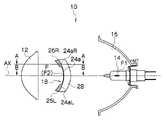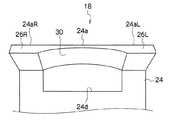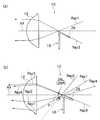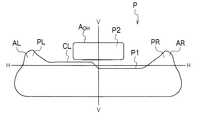JP2013200981A - Vehicular lamp fitting - Google Patents
Vehicular lamp fittingDownload PDFInfo
- Publication number
- JP2013200981A JP2013200981AJP2012067883AJP2012067883AJP2013200981AJP 2013200981 AJP2013200981 AJP 2013200981AJP 2012067883 AJP2012067883 AJP 2012067883AJP 2012067883 AJP2012067883 AJP 2012067883AJP 2013200981 AJP2013200981 AJP 2013200981A
- Authority
- JP
- Japan
- Prior art keywords
- light
- projection lens
- shade
- light source
- distribution pattern
- Prior art date
- Legal status (The legal status is an assumption and is not a legal conclusion. Google has not performed a legal analysis and makes no representation as to the accuracy of the status listed.)
- Pending
Links
Images
Classifications
- F—MECHANICAL ENGINEERING; LIGHTING; HEATING; WEAPONS; BLASTING
- F21—LIGHTING
- F21W—INDEXING SCHEME ASSOCIATED WITH SUBCLASSES F21K, F21L, F21S and F21V, RELATING TO USES OR APPLICATIONS OF LIGHTING DEVICES OR SYSTEMS
- F21W2102/00—Exterior vehicle lighting devices for illuminating purposes
- F21W2102/10—Arrangement or contour of the emitted light
- F21W2102/17—Arrangement or contour of the emitted light for regions other than high beam or low beam
- F21W2102/18—Arrangement or contour of the emitted light for regions other than high beam or low beam for overhead signs
Landscapes
- Non-Portable Lighting Devices Or Systems Thereof (AREA)
Abstract
Translated fromJapaneseDescription
Translated fromJapanese本発明は、車両用灯具に係り、特に、シェードを用いたプロジェクタ型の車両用灯具に関する。 The present invention relates to a vehicular lamp, and more particularly to a projector-type vehicular lamp using a shade.
従来、車両用灯具の分野においては、シェードを用いたいわゆるプロジェクタ型の車両用灯具が提案されている(例えば、特許文献1参照)。 Conventionally, in the field of vehicle lamps, a so-called projector-type vehicle lamp using a shade has been proposed (see, for example, Patent Document 1).
図8は、特許文献1に記載の車両用灯具200の縦断面図である。 FIG. 8 is a longitudinal sectional view of the
図8に示すように、特許文献1に記載の車両用前照灯200は、車両前後方向に延びる光軸AX上に配置された投影レンズ210と、投影レンズ210の後側焦点Fより後方に配置された光源220と、光源220からの光を前方に向けて光軸AX寄りに反射させる反射面230と、投影レンズ210と光源220との間に配置され、反射面230で反射される光源220からの光のうち投影レンズ210を透過して上向きに照射される光を遮光するシェード240と、を備えている。 As shown in FIG. 8, the
光源220は、ハロゲン電球等のバルブ光源である。反射面230は、第1焦点F1が光源220又はその近傍に配置され、第2焦点F2が投影レンズ210の後側焦点F又はその近傍に配置された回転楕円系の反射面である。シェード240は、上端縁241が投影レンズ210の後側焦点F又はその近傍を通るように投影レンズ210と光源220との間に配置されている。シェード240の上端部には、貫通穴242が形成されている。 The
上記構成の車両用前照灯200においては、光源220から放出される光は、反射面230で反射されて投影レンズ210の後側焦点F近傍に集光するとともに、一部(投影レンズを透過して上向きに照射される光)がシェード240により遮光された後、投影レンズ210を透過して前方に照射され、車両前面に正対した仮想鉛直スクリーン(例えば、車両前方約25mに配置されている)上に、図9に示すように、シェード240により規定されるカットオフラインCLを含む基本配光パターンPa(ロービーム用配光パターン)を形成する。 In the
また、光源220から放出される光のうち、光軸AXより下方の反射面230の一部231で反射された光が、シェード240の上部に形成された貫通穴242を通過し、投影レンズ210を透過して前方斜め上方に照射され、オーバーヘッドサイン領域を照射するオーバーヘッド配光パターンPbを形成する(図9参照)。 Of the light emitted from the
しかしながら、上記構成の車両用灯具200においては、基本配光パターンPa及びオーバーヘッド配光パターンPbを形成することが可能となるものの、反射面230の一部231が、オーバーヘッド配光パターンPbを形成する光を反射する領域として用いられているため、その分、基本配光パターンPaを形成する光を反射する領域が浸食されてしまうという問題がある。 However, in the
本発明は、このような事情に鑑みてなされたものであり、基本配光パターンを形成する光を反射する領域を浸食することなく、基本配光パターン及びオーバーヘッド配光パターンを形成することが可能な車両用灯具を提供することを目的とする。 The present invention has been made in view of such circumstances, and it is possible to form a basic light distribution pattern and an overhead light distribution pattern without eroding a region that reflects light forming the basic light distribution pattern. An object of the present invention is to provide a vehicular lamp.
上記目的を達成するため、請求項1に記載の発明は、車両前後方向に延びる光軸上に配置された投影レンズと、前記投影レンズの後側焦点より後方に配置された光源と、前記光源からの光を前方に向けて前記光軸寄りに反射させる反射面と、前記投影レンズと前記光源との間に配置され、前記反射面で反射される前記光源からの光のうち前記投影レンズを透過して上向きに照射される光を遮光するシェードと、を備え、前記シェードにより規定されるカットオフラインを含む基本配光パターンを形成する車両用灯具において、前記光源は、その中心から全方向へ光を放出する光源であり、前記反射面は、前記投影レンズの光取り込み角に対応する基本反射領域と、前記投影レンズの光取り込み角の下方外側に延長された延長反射領域と、を含んでおり、前記シェードは、前記投影レンズの後側焦点又はその近傍を通り、前記投影レンズの焦点面に沿って水平方向に延びる上端縁を含むシェード本体と、前記上端縁から後方に向かって斜め下方に延びる後側延長部と、前記後側延長部の上面に形成された後側反射面と、前記後側延長部の下面に形成された内側反射面と、を備えており、前記シェード本体の上端部には、前記内側反射面で反射された前記延長反射領域からの反射光が通過する貫通穴が形成されており、前記内側反射面で反射された前記延長反射領域からの反射光が、前記貫通穴を通過し、前記投影レンズを透過して前方斜め上方へ照射され、車両前面に正対する仮想鉛直スクリーン上のオーバーヘッドサイン領域を照射するオーバーヘッド配光パターンを形成することを特徴とする。 In order to achieve the above object, the invention according to
請求項1に記載の発明によれば、光源から放出された光が、基本反射領域(従来の基本配光パターンを形成する光を反射する領域に相当)ではなく、投影レンズの光取り込み角の下方外側に延長された延長反射領域及び内側反射面で二回反射されてシェードの上端部に形成された貫通穴を通過し、投影レンズを透過して前方斜め上方へ照射され、車両前面に正対する仮想鉛直スクリーン上のオーバーヘッドサイン領域を照射するオーバーヘッド配光パターンを形成する構成であるため、基本配光パターンを形成する光を反射する領域を浸食することなく、基本配光パターン及びオーバーヘッド配光パターンを形成することが可能となる。 According to the first aspect of the present invention, the light emitted from the light source is not the basic reflection region (corresponding to the region that reflects the light forming the conventional basic light distribution pattern) but the light capture angle of the projection lens. The light is reflected twice by the extended reflection area and the inner reflection surface that extend downward and outward, passes through the through-hole formed in the upper end of the shade, passes through the projection lens, and is irradiated obliquely upward and forward, and is directed to the front of the vehicle. On the other hand, since the overhead light distribution pattern that irradiates the overhead sign area on the virtual vertical screen is formed, the basic light distribution pattern and the overhead light distribution are obtained without eroding the area that reflects the light forming the basic light distribution pattern. A pattern can be formed.
請求項2に記載の発明は、請求項1に記載の発明において、前記シェードは、前記上端縁の両端部から前方に向かって斜め下方に延びる前側延長部の上面に形成された反射面であって、これに入射した前記光源からの光を反射して前記投影レンズを透過させ、車両前面に正対する仮想鉛直スクリーン上の水平線より上の左右側方領域を照射し、前記基本配光パターンに付加される付加配光パターンを形成する前側反射面と、を備えることを特徴とする。 According to a second aspect of the present invention, in the first aspect of the present invention, the shade is a reflecting surface formed on the upper surface of a front extension extending obliquely downward from both ends of the upper edge toward the front. Then, the light from the light source incident thereon is reflected and transmitted through the projection lens, and the left and right lateral regions above the horizontal line on the virtual vertical screen facing the front of the vehicle are irradiated to the basic light distribution pattern. And a front reflective surface for forming an additional light distribution pattern to be added.
請求項2に記載の発明によれば、上端縁のうち両端部から前方に向かって斜め下方に延びる前側反射面の作用により、光源から全方向へ放出されて当該前側反射面へあらゆる方向から入射する光を反射して投影レンズを透過させることで、水平線より上の左右側方領域のみを照射し、左右側方領域の間の領域を照射しない付加配光パターンが付加された、シェード(上端縁)により規定されるカットオフラインを含む基本配光パターンを形成することが可能となる(前側反射面間に前側反射面は存在しないため、左右側方領域間の領域は照射されない)。 According to the second aspect of the present invention, the front side reflection surface extending obliquely downward from both ends of the upper end edge emits the light from the light source in all directions and enters the front side reflection surface from all directions. By reflecting the light to be transmitted and passing through the projection lens, only the left and right side areas above the horizontal line are irradiated, and an additional light distribution pattern that does not irradiate the area between the left and right side areas is added. It is possible to form a basic light distribution pattern including a cut-off line defined by (edge) (since there is no front reflection surface between the front reflection surfaces, the region between the left and right side regions is not irradiated).
以上のように、請求項2に記載の発明によれば、水平線より上の左右側方領域のみを照射し、左右側方領域の間の領域を照射しない付加配光パターンが付加されるため、対向車や先行車に対するグレアを抑えつつ、水平線より上の左右側方領域に存在する歩行者や障害物等を照明することが可能となる。 As described above, according to the invention described in claim 2, since the additional light distribution pattern that irradiates only the left and right side regions above the horizontal line and does not irradiate the region between the left and right side regions is added, It is possible to illuminate pedestrians, obstacles, and the like existing in the left and right side regions above the horizon while suppressing glare for oncoming vehicles and preceding vehicles.
本発明によれば、基本配光パターンを形成する光を反射する領域を浸食することなく、基本配光パターン及びオーバーヘッド配光パターンを形成することが可能な車両用灯具を提供することが可能となる。 According to the present invention, it is possible to provide a vehicular lamp that can form a basic light distribution pattern and an overhead light distribution pattern without eroding a region that reflects light forming the basic light distribution pattern. Become.
以下、本発明の一実施形態である車両用灯具10(車両用前照灯)について、図面を参照しながら説明する。 Hereinafter, a vehicle lamp 10 (vehicle headlamp) according to an embodiment of the present invention will be described with reference to the drawings.
図1は本発明の一実施形態である車両用灯具10を、その光軸AXを含む水平面で切断した断面図、図2(a)は図1に示した車両用灯具10を、その光軸AXを含む鉛直面で切断した断面図、図2(b)は図1に示した車両用灯具10のA−A断面図、図3は光源14の例、図4は前側反射面26L、26R及び後側反射面28の斜視図、図5はシェード18の正面図、図6(a)は図1に示した車両用灯具10のB−B断面図、図6(b)は図1に示した車両用灯具10のA−A断面図、図7は車両用灯具10により形成される配光パターンP1、P2の例である。 FIG. 1 is a cross-sectional view of a
本実施形態の車両用灯具10は、図1、図2(a)、図2(b)に示すように、ロービーム用配光パターンを形成するプロジェクタ型の灯具ユニットであり、車両前後方向に延びる光軸AX上に配置された投影レンズ12、投影レンズ12の後側焦点Fより後方に配置された光源14、光源14からの光を前方に向けて光軸AX寄りに反射させる反射面16、投影レンズ12と光源14との間に配置され、反射面16で反射される光源14からの光のうち投影レンズ12を透過して上向きに照射される光を遮光するシェード18等を備えている。 The
投影レンズ12は、前方側表面が凸面で後方側表面が平面の平凸レンズであり、ホルダ(図示せず)により保持されて、光軸AX上に配置されている。 The
光源14は、その中心から全方向へ光を放出する光源であり、例えば、ハロゲン電球、HID電球である。光源14は、その中心から全方向へ光を放出する光源であればよく、その構造は特に問わない。例えば、光源14は、図3に示すように、半球方向に光を放出する半導体発光素子(例えば、LED(発光ダイオード)やLD(レーザーダイオード)を用いた2つの光源20、20、例えば、LEDと蛍光体とを組み合わせた構造の白色光源(又は、LDと蛍光体とを組み合わせた構造の白色光源)の背面同士が基板22を間に挟んで対向した構造の光源、その他構造の光源であってもよい。 The
反射面16は、第1焦点F1が光源14又はその近傍に設定され、第2焦点F2が投影レンズ12の後側焦点F又はその近傍に設定された回転楕円系の反射面(回転楕円面又はこれに類する自由曲面等)である。 The
図2(a)に示すように、反射面16は、投影レンズ12の光取り込み角αに対応する基本反射領域16aと、投影レンズ12の光取り込み角αの下方外側に延長された延長反射領域16b(角度βに対応する延長反射領域16b)と、を含んでいる。なお、光取り込み角αとは、投影レンズ12(有効径)の径方向両端と投影レンズ12の焦点Fとを結んだ2本の直線がなす角度のことである。 As shown in FIG. 2A, the
図1、図2(a)、図2(b)、図4、図5に示すように、シェード18は、投影レンズ12の後側焦点F又はその近傍を通り、投影レンズ12の焦点面に沿って左右段違いで水平方向に延びる上端縁24aを含むシェード本体24と、上端縁24aの両端部24aL、24aRから前方に向かって斜め下方に延びる前側延長部24bL、24bRの上面に形成された前側反射面26L、26Rと、上端縁24aから後方に向かって斜め下方に延びる後側延長部24cの上面に形成された後側反射面28と、後側延長部24cの下面に形成された内側反射面30と、を備えている。シェード本体24の上端部には、内側反射面30で反射された反射面16(延長反射領域16b)からの反射光が通過する貫通穴24dが形成されている(図2(a)、図5参照)。 As shown in FIGS. 1, 2 (a), 2 (b), 4, and 5, the
前側反射面26L、26Rは、鉛直断面が直線で(図2(b)参照)、水平断面が上端縁24aに沿って湾曲した曲面形状の反射面であり(図1、図4参照)、例えば、上端縁24aの両端部24aL、24aRから前方に向かって斜め下方に延びたシェード18の前側延長部24bL、24bRの上面に対して鏡面研磨又はアルミ等の金属蒸着を施すことで形成されている。あるいは、シェード18の前側延長部24bL、24bRの上面に薄い板状の反射板を貼り付けることで形成してもよい。前側反射面26L、26Rは、鉛直断面が直線に限られず、曲線であってもよい。前側反射面26L、26Rの鉛直断面の形状(及び/又は水平断面の形状)を調整することで、水平線H−Hより上の左右側方領域の高さ寸法(及び/又は水平方向寸法)を調整することが可能となる。 The
図2(b)に示すように、前側反射面26L、26Rの水平面に対する傾斜角度θ1は、光源14から全方向へ放出されて投影レンズ12へ入射する光(例えば、図6(a)、図6(b)中、光軸AXより上の基本反射領域16aで反射されるRay1参照)の進路を遮らないように、投影レンズ12の光取り込み角α/2以上の角度とされている。すなわち、前側反射面26L、26Rは、光源14から全方向へ放出されて投影レンズ12へ入射する光(例えば、図6(a)、図6(b)中、光軸AXより上の基本反射領域16aで反射されるRay1参照)の進路を遮らないように、投影レンズ12の光取り込み角αの下方外側において、前方斜め下方に延びている。 As shown in FIG. 2B, the inclination angle θ1 of the front
上記構成の前側反射面26L、26Rによれば、光源14から全方向へ放出され、前側反射面26L、26Rへあらゆる方向から入射する光(例えば、図6(b)中、光軸AXより上の基本反射領域16aで反射されて比較的きつい角度で入射するRay2参照)は、当該前側反射面26L、26Rで反射されて投影レンズ12を透過し、車両前面に正対する仮想鉛直スクリーン上の水平線H−Hより上の左右側方領域AL、ARを照射する付加配光パターンPL、PRを形成する(図7参照)。なお、左右側方領域AL、ARを照射する付加配光パターンPL、PRの鉛直方向寸法は、前側反射面26L、26Rの長さ及び/又は前側反射面26L、26Rの水平面に対する傾斜角度θ1を調整することで、調整可能である。また、左右側方領域AL、ARを照射する付加配光パターンPL、PRの水平方向寸法は、前側反射面26L、26Rの水平方向寸法を調整することで、調整可能である。 According to the front reflection surfaces 26L and 26R having the above-described configuration, light emitted from the
なお、前側反射面26L、26Rは、水平線H−Hより上の左右9度より外側に対応する範囲に設けるのが望ましい。このようにすれば、水平線H−Hより上の左右9度より外側の左右側方領域AL、ARのみを照射し、左右側方領域AL、ARの間の領域を照射しない付加配光パターンPL、PRを形成することが可能となる。前側反射面26L、26Rを左右9度より外側に対応する範囲に設ける理由は、仮に前側反射面26L、26Rを左右9度より内側に対応する範囲に設けると、その反射光が対向車又は先行車に対してグレアを与えることとなるため、これを防止するためである(ECE規則では、左右9度より内側にグレアが存在しないことが求められている)。 The
後側反射面28は、鉛直断面が直線で(図2(a)、図2(b)参照)、水平断面が上端縁24aに沿って湾曲した曲面形状の反射面であり(図1、図4参照)、例えば、上端縁24aから後方に向かって斜め下方に延びたシェード18の後側延長部24cの上面に対して鏡面研磨又はアルミ等の金属蒸着を施すことで形成されている。あるいは、シェード18の後側延長部24cの上面に薄い板状の反射板を貼り付けることで形成してもよい。後側反射面28は、鉛直断面が直線に限られず、曲線であってもよい。 The
図2(a)に示すように、後側反射面28の水平面に対する傾斜角度θ2は、光源14から全方向へ放出されて投影レンズ12へ入射する光(例えば、図6(a)、図6(b)中、光軸AXより下の基本反射領域16aで反射される光Ray3参照)の進路を遮らないように、投影レンズ12の光取り込み角α/2以上の角度とされている。すなわち、後側反射面28は、光源14から全方向へ放出されて投影レンズ12へ入射する光(例えば、図6(a)、図6(b)中、光軸AXより下の基本反射領域16aで反射される光Ray3参照)の進路を遮らないように、投影レンズ12の光取り込み角αの下方外側において、前方斜め下方に延びている。 As shown in FIG. 2A, the inclination angle θ2 of the rear
上記構成の後側反射面28によれば、光源14から全方向へ放出され、後側反射面28へあらゆる方向から入射する光のうち少なくとも一部(例えば、図6(b)中、光軸AXより上の基本反射領域16aで反射されて比較的浅い角度で入射するRay4参照)は、当該後側反射面28で反射されて投影レンズ12を透過して屈折し、路面方向に向かう。すなわち、光源14から全方向へ放出され、後側反射面28へあらゆる方向から入射する光のうち少なくとも一部(例えば、図6(b)中、光軸AXより下の基本反射領域16aで反射されて比較的浅い角度で入射するRay4参照)は、上端縁24a(カットオフラインCL)を境に折り返されてカットオフラインCL以下の基本配光パターンP1に重畳される形となる。これにより、車両用灯具10の光利用効率を高めることが可能となる。 According to the rear
内側反射面30は、シェード18の後側延長部24cの下面のうち、オーバーヘッドサイン領域(例えば、水平線H−Hより上0〜4度、左右9度の範囲)に対応する範囲に設定されている。内側反射面30は、鉛直断面が直線で(図2(a)参照)、水平断面が凹状に湾曲した曲面形状の反射面であり(図5参照)、例えば、上端縁24aから後方に向かって斜め下方に延びたシェード18の後側延長部24cの下面に対して鏡面研磨又はアルミ等の金属蒸着を施すことで形成されている。あるいは、シェード18の後側延長部24cの下面に薄い板状の反射板を貼り付けることで形成してもよい。内側反射面30は、鉛直断面が直線に限られず、曲線であってもよい。 The
上記のように、内側反射面30の水平断面を凹状に湾曲した曲面形状とすることで、シェード18の後側延長部24cを、中央部が薄肉で両端部(図5中、左右方向の両端部)が厚肉の成形しやすい構造とすることが可能となる。換言すれば、上記のように、内側反射面30の水平断面を湾曲した曲面形状とすることで、シェード18(後側延長部24c)の強度を保ちながら、オーバーヘッドサイン領域AOHを照射するオーバーヘッド配光パターンP2を形成することが可能となる。As described above, by making the horizontal cross section of the
上記構成の内側反射面30によれば、光源14から全方向へ放出され、反射面16(延長反射領域16b)で反射されて内側反射面30へ入射する光(例えば、図2(a)中、Ray5参照)は、当該内側反射面30で反射されてシェード本体24に形成された貫通穴24d(図2(a)、図5参照)を通過し、投影レンズ12を透過して屈折し、前方斜め上方へ照射されてオーバーヘッドサイン領域AOHを照射するオーバーヘッド配光パターンP2を形成する(図7参照)。According to the
反射面16(延長反射領域16b)で反射される光(例えば、図2(a)中、Ray5参照)は、投影レンズ12の光取り込み角αの下方外側を進行する光であり、本来、投影レンズ12へ入射せず基本配光パターンP1に寄与しない光である。 The light reflected by the reflection surface 16 (extended
これに対して、上記構成の内側反射面30によれば、内側反射面30の作用により、反射面16(延長反射領域16b)で反射される光(例えば、図2(a)中、Ray5参照)を反射させてシェード本体24に形成された貫通穴24d(図2(a)、図5参照)を通過させ、投影レンズ12を透過させ、オーバーヘッドサイン領域AOHを照射するオーバーヘッド配光パターンP2を形成することが可能となる。これにより、車両用灯具10の光利用効率を高めることが可能となる。On the other hand, according to the
上記構成の車両用灯具10によれば、図2(a)に示すように、光源14から全方向へ放出された光は、反射面16(基本反射領域16a)で反射され、前側反射面26L、26R及び後側反射面28で遮られることなく、投影レンズ12の後側焦点F近傍に集光するとともに、一部(投影レンズ12を透過して上向きに照射される光)がシェード18により遮光された後、投影レンズ12を透過して前方に照射され、車両前面に正対した仮想鉛直スクリーン(例えば、車両前方約25mに配置されている)上に、シェード18(上端縁24a)により規定されるカットオフラインCLを含む基本配光パターンP1(ロービーム用配光パターン)を形成する(図7参照)。 According to the
この基本配光パターンP1(ロービーム用配光パターン)には、前側反射面26L、26Rで反射される反射光により形成される付加配光パターンPL、PR、及び、延長反射領域16b及び内側反射面30で二回反射される反射光により形成されるオーバーヘッド配光パターンP2が付加される(図7参照)。 The basic light distribution pattern P1 (low beam light distribution pattern) includes additional light distribution patterns PL and PR formed by reflected light reflected by the front
以上説明したように、本実施形態の車両用灯具10によれば、光源14から放出された光が、基本反射領域16a(従来の基本配光パターンを形成する光を反射する領域に相当)ではなく、投影レンズ12の光取り込み角αの下方外側に延長された延長反射領域16b及び内側反射面30で二回反射し、シェード18の上端部に形成された貫通穴24dを通過し、投影レンズ12を透過して前方斜め上方へ照射され、車両前面に正対する仮想鉛直スクリーン上のオーバーヘッドサイン領域AOHを照射するオーバーヘッド配光パターンP2を形成する構成であるため、基本配光パターンP1を形成する光を反射する領域(基本反射領域16a)を浸食することなく、基本配光パターンP1及びオーバーヘッド配光パターンP2を形成することが可能となる。As described above, according to the
また、本実施形態の車両用灯具10によれば、上端縁24aのうち両端部24L、24Rから前方に向かって斜め下方に延びる前側反射面26L、26Rの作用により、光源14から全方向へ放出されて当該前側反射面26L、26Rへあらゆる方向から入射する光(例えば、図6(b)中、光軸AXより上の基本反射領域16aで反射されて比較的きつい角度で入射するRay2参照)を反射して投影レンズ12を透過させることで、水平線H−Hより上の左右側方領域AL、ARのみを照射し、左右側方領域AL、ARの間の領域を照射しない付加配光パターンPL、PRが付加された、シェード18(上端縁24a)により規定されるカットオフラインCLを含む基本配光パターンP1を形成することが可能となる(前側反射面26L、26R間に前側反射面は存在しないため、左右側方領域AL、AR間の領域は照射されない)。 Further, according to the
以上のように、本実施形態の車両用灯具10によれば、水平線H−Hより上の左右側方領域AL、ARのみを照射し、左右側方領域AL、ARの間の領域を照射しない付加配光パターンPL、PRが付加されるため、対向車や先行車に対するグレアを抑えつつ、水平線H−Hより上の左右側方領域AL、ARに存在する歩行者や障害物等を照明することが可能となる。 As described above, according to the
前側反射面26L、26Rへ比較的きつい角度で入射する光(例えば、図6(b)中のRay2参照)は、投影レンズ12の光取り込み角αの上方外側を進行する光であり、本来、投影レンズ12へ入射せず基本配光パターンP1に寄与しない光である(図6(b)点線参照)。 Light that is incident on the
これに対して、本実施形態の車両用灯具10によれば、前側反射面26L、26Rの作用により、前側反射面26L、26Rへ比較的きつい角度で入射する光(例えば、図6(b)中のRay2参照)を反射させて投影レンズ12を透過させ、付加配光パターンPL、PRの形成に用いることが可能となる。これにより、車両用灯具10の光利用効率を高めることが可能となる。 On the other hand, according to the
また、本実施形態の車両用灯具10によれば、上端縁24aから後方に向かって斜め下方に延びる後側反射面28の作用により、光源14から全方向へ放出されて当該後側反射面28にあらゆる方向から入射する光のうち少なくとも一部(例えば、図6(b)中、光軸AXより上の基本反射領域16aで反射されて比較的浅い角度で入射するRay4参照)を反射して投影レンズ12を透過させ、前方に照射することが可能となるため、車両用灯具10の光利用効率を高めることが可能となる。 Further, according to the
上記実施形態はあらゆる点で単なる例示にすぎない。これらの記載によって本発明は限定的に解釈されるものではない。本発明はその精神または主要な特徴から逸脱することなく他の様々な形で実施することができる。 The above embodiment is merely an example in all respects. The present invention is not construed as being limited to these descriptions. The present invention can be implemented in various other forms without departing from the spirit or main features thereof.
10…車両用灯具、12…投影レンズ、14…光源、16…反射面、18…シェード、24…上端縁、26L、26R…前側反射面、28…後側反射面 DESCRIPTION OF
Claims (2)
Translated fromJapanese前記光源は、その中心から全方向へ光を放出する光源であり、
前記反射面は、前記投影レンズの光取り込み角に対応する基本反射領域と、前記投影レンズの光取り込み角の下方外側に延長された延長反射領域と、を含んでおり、
前記シェードは、前記投影レンズの後側焦点又はその近傍を通り、前記投影レンズの焦点面に沿って水平方向に延びる上端縁を含むシェード本体と、前記上端縁から後方に向かって斜め下方に延びる後側延長部と、前記後側延長部の上面に形成された後側反射面と、前記後側延長部の下面に形成された内側反射面と、を備えており、
前記シェード本体の上端部には、前記内側反射面で反射された前記延長反射領域からの反射光が通過する貫通穴が形成されており、
前記内側反射面で反射された前記延長反射領域からの反射光が、前記貫通穴を通過し、前記投影レンズを透過して前方斜め上方へ照射され、車両前面に正対する仮想鉛直スクリーン上のオーバーヘッドサイン領域を照射するオーバーヘッド配光パターンを形成することを特徴とする車両用灯具。A projection lens disposed on an optical axis extending in the longitudinal direction of the vehicle, a light source disposed behind a rear focal point of the projection lens, and a reflection that reflects light from the light source forward and closer to the optical axis And a shade that is disposed between the projection lens and the light source, and shields light that passes through the projection lens and is irradiated upward from light from the light source reflected by the reflection surface. A vehicular lamp that forms a basic light distribution pattern including a cut-off line defined by the shade,
The light source is a light source that emits light in all directions from its center,
The reflection surface includes a basic reflection region corresponding to a light capture angle of the projection lens, and an extended reflection region extended to the lower outside of the light capture angle of the projection lens,
The shade passes through or near the rear focal point of the projection lens, and includes a shade body including an upper end edge that extends in the horizontal direction along the focal plane of the projection lens, and extends obliquely downward from the upper edge toward the rear. A rear extension, a rear reflective surface formed on the upper surface of the rear extension, and an inner reflective surface formed on the lower surface of the rear extension,
A through-hole through which reflected light from the extended reflection area reflected by the inner reflection surface passes is formed at the upper end of the shade body,
Reflected light from the extended reflection area reflected by the inner reflection surface passes through the through-hole, passes through the projection lens, is irradiated obliquely forward and upward, and is overhead on a virtual vertical screen facing the front of the vehicle. A vehicular lamp characterized by forming an overhead light distribution pattern for irradiating a sign area.
Priority Applications (3)
| Application Number | Priority Date | Filing Date | Title |
|---|---|---|---|
| JP2012067883AJP2013200981A (en) | 2012-03-23 | 2012-03-23 | Vehicular lamp fitting |
| US13/846,803US8956029B2 (en) | 2012-03-23 | 2013-03-18 | Vehicle lighting unit |
| KR1020130029842AKR102006319B1 (en) | 2012-03-23 | 2013-03-20 | Vehicle lighting unit |
Applications Claiming Priority (1)
| Application Number | Priority Date | Filing Date | Title |
|---|---|---|---|
| JP2012067883AJP2013200981A (en) | 2012-03-23 | 2012-03-23 | Vehicular lamp fitting |
Publications (1)
| Publication Number | Publication Date |
|---|---|
| JP2013200981Atrue JP2013200981A (en) | 2013-10-03 |
Family
ID=49546738
Family Applications (1)
| Application Number | Title | Priority Date | Filing Date |
|---|---|---|---|
| JP2012067883APendingJP2013200981A (en) | 2012-03-23 | 2012-03-23 | Vehicular lamp fitting |
Country Status (1)
| Country | Link |
|---|---|
| JP (1) | JP2013200981A (en) |
Cited By (6)
| Publication number | Priority date | Publication date | Assignee | Title |
|---|---|---|---|---|
| JP2014203513A (en)* | 2013-04-01 | 2014-10-27 | 株式会社小糸製作所 | Vehicle lighting appliance |
| KR101557112B1 (en) | 2014-04-22 | 2015-10-02 | 에스엘 주식회사 | Lamp for vehicle |
| US9410671B2 (en) | 2014-03-27 | 2016-08-09 | Hyundai Motor Company | Head lamp for vehicle |
| US9447941B2 (en) | 2014-03-13 | 2016-09-20 | Sl Corporation | Lamp for vehicle |
| CN111288410A (en)* | 2018-12-07 | 2020-06-16 | 深圳市绎立锐光科技开发有限公司 | A lighting device and a vehicle using the same |
| CN112664899A (en)* | 2015-05-22 | 2021-04-16 | 三菱电机株式会社 | Headlight module |
Citations (5)
| Publication number | Priority date | Publication date | Assignee | Title |
|---|---|---|---|---|
| JP2001035218A (en)* | 1999-07-19 | 2001-02-09 | Koito Mfg Co Ltd | Headlamp for vehicle |
| JP2007294203A (en)* | 2006-04-24 | 2007-11-08 | Koito Mfg Co Ltd | Vehicular headlamp |
| JP2008198483A (en)* | 2007-02-13 | 2008-08-28 | Koito Mfg Co Ltd | Vehicle headlight |
| JP2010108728A (en)* | 2008-10-30 | 2010-05-13 | Koito Mfg Co Ltd | Vehicular lamp unit and vehicular lamp |
| JP2011146213A (en)* | 2010-01-14 | 2011-07-28 | Koito Mfg Co Ltd | Headlamp for vehicle |
- 2012
- 2012-03-23JPJP2012067883Apatent/JP2013200981A/enactivePending
Patent Citations (5)
| Publication number | Priority date | Publication date | Assignee | Title |
|---|---|---|---|---|
| JP2001035218A (en)* | 1999-07-19 | 2001-02-09 | Koito Mfg Co Ltd | Headlamp for vehicle |
| JP2007294203A (en)* | 2006-04-24 | 2007-11-08 | Koito Mfg Co Ltd | Vehicular headlamp |
| JP2008198483A (en)* | 2007-02-13 | 2008-08-28 | Koito Mfg Co Ltd | Vehicle headlight |
| JP2010108728A (en)* | 2008-10-30 | 2010-05-13 | Koito Mfg Co Ltd | Vehicular lamp unit and vehicular lamp |
| JP2011146213A (en)* | 2010-01-14 | 2011-07-28 | Koito Mfg Co Ltd | Headlamp for vehicle |
Cited By (7)
| Publication number | Priority date | Publication date | Assignee | Title |
|---|---|---|---|---|
| JP2014203513A (en)* | 2013-04-01 | 2014-10-27 | 株式会社小糸製作所 | Vehicle lighting appliance |
| US9447941B2 (en) | 2014-03-13 | 2016-09-20 | Sl Corporation | Lamp for vehicle |
| US9410671B2 (en) | 2014-03-27 | 2016-08-09 | Hyundai Motor Company | Head lamp for vehicle |
| KR101557112B1 (en) | 2014-04-22 | 2015-10-02 | 에스엘 주식회사 | Lamp for vehicle |
| CN112664899A (en)* | 2015-05-22 | 2021-04-16 | 三菱电机株式会社 | Headlight module |
| CN112664899B (en)* | 2015-05-22 | 2022-10-25 | 三菱电机株式会社 | Headlight module |
| CN111288410A (en)* | 2018-12-07 | 2020-06-16 | 深圳市绎立锐光科技开发有限公司 | A lighting device and a vehicle using the same |
Similar Documents
| Publication | Publication Date | Title |
|---|---|---|
| JP6052569B2 (en) | Vehicle lamp unit | |
| JP6410341B2 (en) | Vehicle headlamp | |
| JP4413839B2 (en) | Vehicle headlamp lamp unit | |
| JP5848920B2 (en) | Vehicle headlamp | |
| KR101393659B1 (en) | Car headlight | |
| JP5692521B2 (en) | Motorcycle headlights | |
| JP5897913B2 (en) | Lamp unit | |
| JP2011040247A (en) | Lamp unit of headlight for vehicle | |
| JP2011165600A (en) | Vehicular illumination lamp | |
| JP2013200981A (en) | Vehicular lamp fitting | |
| JP2008258001A (en) | Lamp unit of vehicular headlamp | |
| JP2015076243A (en) | Vehicular lighting tool | |
| JP2011025820A (en) | Vehicular lighting fixture | |
| JP2010282790A (en) | Vehicle lighting | |
| US8956029B2 (en) | Vehicle lighting unit | |
| JP2009104790A (en) | Vehicle headlamp | |
| JP5958004B2 (en) | Vehicle lighting | |
| JP2015002128A (en) | Vehicle lighting | |
| JP2012199156A (en) | Vehicle headlamp | |
| JP5979414B2 (en) | Vehicle lighting | |
| JP2009152056A (en) | Vehicle lighting | |
| JP5013080B2 (en) | Projector type headlight | |
| JP2007207687A (en) | Vehicle lighting | |
| JP6711724B2 (en) | Vehicle headlights | |
| JP4587047B2 (en) | Vehicle lighting |
Legal Events
| Date | Code | Title | Description |
|---|---|---|---|
| A621 | Written request for application examination | Free format text:JAPANESE INTERMEDIATE CODE: A621 Effective date:20150306 | |
| A977 | Report on retrieval | Free format text:JAPANESE INTERMEDIATE CODE: A971007 Effective date:20151126 | |
| A131 | Notification of reasons for refusal | Free format text:JAPANESE INTERMEDIATE CODE: A131 Effective date:20151130 | |
| A02 | Decision of refusal | Free format text:JAPANESE INTERMEDIATE CODE: A02 Effective date:20160323 |








